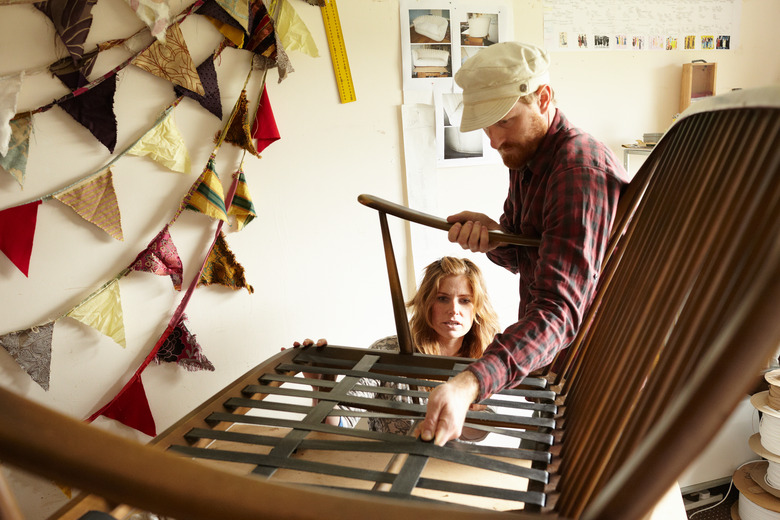How To Repair Webbing Straps For A Couch
Flopping on the couch at the end of a busy day is one of the unparalleled joys of adulthood, but it can take a toll on your beloved sofa. Many couches are supported by a loose basket-weave of stretchy straps attached to the sofa's wooden frame. Age and constant flopping can make this supportive sofa elastic belt stretch out too far, lose its elasticity or even detach from the frame, making your sofa saggy and uncomfortable. Repairing or replacing couch webbing straps can give a beloved old sofa a new lease on life.
Gather Your Tools and Supplies
Gather Your Tools and Supplies
A heavy-duty staple remover is your best friend when replacing worn couch webbing. You will also need a small bowl or trash can, a roll of sofa webbing replacement straps, upholstery tacks and a hammer, a webbing stretcher, a staple gun and staples and shears. Depending on how the couch webbing was installed originally, you might also need webbing clips and vise grips. If your couch is very long or very heavy, you may want to enlist at least one helper.
Remove the Old Webbing Straps
Remove the Old Webbing Straps
Remove any throw blankets, loose pillows and unattached cushions from your couch and set them aside. Tip your couch carefully over onto its back. This is where a helper might come in handy. You can also tip it forward, but that might not give you as stable a work surface.
Use your staple puller to remove the staples holding the dust cover in place on the underside of the couch. Make sure to place all staples in a small bowl or trash can so that they don't get stepped on or swallowed by pets or young children. Set the dust cover aside.
Detach the old webbing straps from the couch frame by either removing the upholstery tacks or sliding any clips out of their slots. Remove the old webbing and clips and discard them.
Replace the Couch Webbing Straps
Replace the Couch Webbing Straps
Place the end of the roll of webbing tape in the center of one of the long sides of the couch's wooden frame. Secure it with a thumbtack in the center of the strap where it overlaps the frame. Place the rest of the tacks in a "W" formation. Putting the tacks in a straight line can not only encourage tearing in the strap, it can also cause a crack along the grain of the wooden sofa frame.
If you have precut the straps, thread the unattached end through a webbing stretcher and pull it to the opposite side of the frame. Do not pull it too tight because this can damage the sofa frame. You want the strap to be taut but loose enough that you can pluck it like a very wide guitar string. Attach the loose strap with upholstery tacks in a W shape or clamp a webbing clip to the free end and slide it into its designated slot.
Place your next webbing strap lengthwise in the center of one of the side frames. Continue alternating width-wise and length-wise, weaving the straps over and under each other until you have enough to cover the frame. Remember not to pull them too tight.
Replace the Dust Cover
Replace the Dust Cover
Place the dust cover on top of the new webbing and smooth it out. Place one staple in the center of each side, then attach the corners. Fill in the rest of the staples and return the couch to its upright position.
